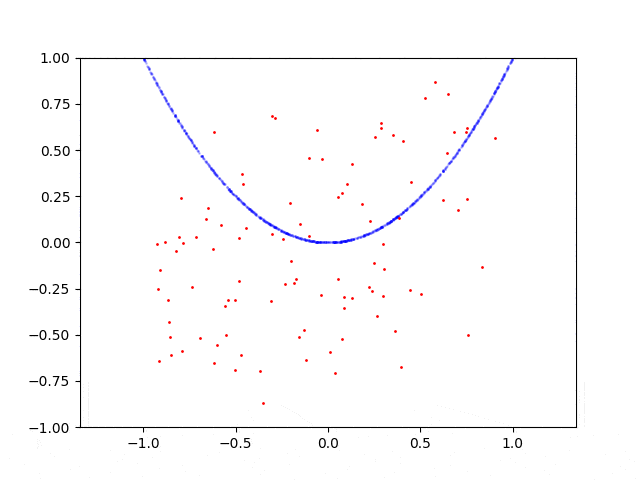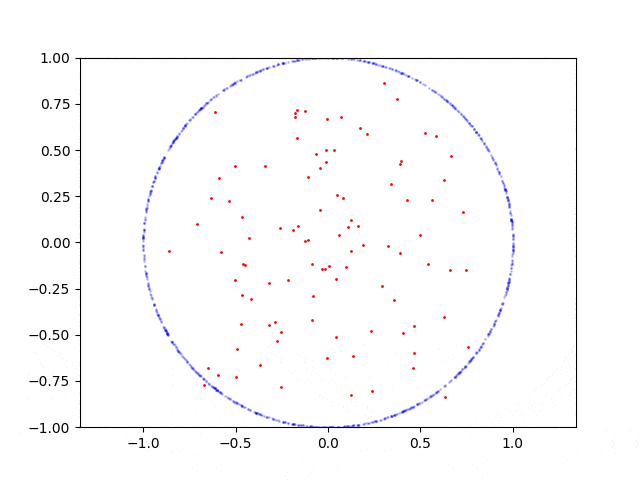我试图在Keras中实现基本的GAN,基于这个实现。
当我在抛物线上采样点时,GAN会收敛并能够从该分布中生成样本,但是如果我例如在圆形上采样点,则失败了。 我想知道为什么GAN很难处理这种情况? 如何修复?
以下是重现代码:
from __future__ import print_function, division
import warnings
warnings.filterwarnings('ignore')
import os
import shutil
from datetime import datetime
from keras.layers import Input, Dense
from keras.layers.advanced_activations import LeakyReLU
from keras.models import Sequential, Model
from keras.optimizers import Adam
from sklearn import datasets
import numpy as np
import tensorflow as tf
from tqdm import tqdm
import matplotlib.pyplot as plt
import cv2
# Derived from original code https://github.com/eriklindernoren/Keras-GAN/blob/master/gan/gan.py
def print_env_info():
print('-' * 60)
import keras
print('keras.__version__', keras.__version__)
print('-' * 60)
import tensorflow as tf
print('tf.__version__', tf.__version__)
print('-' * 60)
class GAN():
def __init__(self):
self.latent_dim = 128
optimizer = Adam(0.0002, 0.5)
# Build and compile the discriminator
self.discriminator = self.build_discriminator()
self.discriminator.compile(loss='binary_crossentropy',
optimizer=optimizer,
metrics=['accuracy'])
# Build the generator
self.generator = self.build_generator()
# The generator takes noise as input and generates imgs
z = Input(shape=(self.latent_dim,))
img = self.generator(z)
# For the combined model we will only train the generator
self.discriminator.trainable = False
# The discriminator takes generated images as input and determines validity
validity = self.discriminator(img)
# The combined model (stacked generator and discriminator)
# Trains the generator to fool the discriminator
self.combined = Model(z, validity)
self.combined.compile(loss='binary_crossentropy', optimizer=optimizer)
# Tensorboard writer
log_dir = "logs/" + datetime.now().strftime("%Y%m%d-%H%M%S")
self.writer = tf.summary.FileWriter(log_dir)
def build_generator(self):
model = Sequential()
model.add(Dense(64, input_dim=self.latent_dim))
model.add(LeakyReLU(alpha=0.2))
model.add(Dense(128, input_dim=2))
model.add(LeakyReLU(alpha=0.2))
model.add(Dense(2, activation='tanh'))
model.summary()
noise = Input(shape=(self.latent_dim,))
img = model(noise)
return Model(noise, img)
def build_discriminator(self):
model = Sequential()
model.add(Dense(64, input_dim=2))
model.add(LeakyReLU(alpha=0.2))
model.add(Dense(128, input_dim=2))
model.add(LeakyReLU(alpha=0.2))
model.add(Dense(1, activation='sigmoid'))
model.summary()
img = Input(shape=(2, ))
validity = model(img)
return Model(img, validity)
def generate_dataset(self, n_samples=10000):
# # V1: y = x^2
x = np.random.uniform(-1, 1, size=n_samples)
y = x ** 2
data = np.stack([x, y], axis=1)
# V2: x ^ 2 + y ^ 2 = 1
# angle = np.random.uniform(0, 1, size=n_samples) * (np.pi * 2)
# x = np.cos(angle)
# y = np.sin(angle)
# data = np.stack([x, y], axis=1)
# V3: swiss roll
# data, _ = datasets.make_swiss_roll(n_samples=n_samples, noise=0.0, random_state=0)
# data = np.stack([data[:, 0], data[:, 2]], axis=1)
# data = data - np.min(data, axis=0)
# data = data / np.max(data, axis=0)
# data = 2 * data - 1.0
# # V4:
# data, _ = datasets.make_moons(n_samples=n_samples, shuffle=False, noise=None, random_state=0)
# data = data - np.min(data, axis=0)
# data = data / np.max(data, axis=0)
# data = 2 * data - 1.0
return data
def summary_image(self, tensor):
import io
from PIL import Image
tensor = tensor.astype(np.uint8)
height, width, channel = tensor.shape
image = Image.fromarray(tensor)
output = io.BytesIO()
image.save(output, format='PNG')
image_string = output.getvalue()
output.close()
return tf.Summary.Image(height=height,
width=width,
colorspace=channel,
encoded_image_string=image_string)
def get_visualization(self, epoch):
def generate_fake_data(n_samples):
noise = np.random.normal(0, 1, (n_samples, self.latent_dim))
X_hat = self.generator.predict(noise)
x = X_hat[:, 0]
y = X_hat[:, 1]
return x, y
def save_figure():
x_fake, y_fake = generate_fake_data(n_samples=100)
data = self.generate_dataset(n_samples=1000)
x_real, y_real = data[:, 0], data[:, 1]
axes = plt.gca()
axes.set_xlim([-1, 1])
axes.set_ylim([-1, 1])
axes.set_aspect('equal', 'datalim')
plt.scatter(x_real, y_real, s=1, color='b', alpha=0.2)
plt.scatter(x_fake, y_fake, s=1, color='r')
plt.savefig(f'images/{epoch}.png')
plt.close()
save_figure()
image = cv2.imread(f'images/{epoch}.png')
image = self.summary_image(image)
return image
def train(self, epochs, batch_size, sample_interval):
# Load the dataset
X_train = self.generate_dataset()
print('X_train.shape', X_train.shape)
# Adversarial ground truths
valid = np.ones((batch_size, 1))
fake = np.zeros((batch_size, 1))
for epoch in tqdm(range(epochs), total=epochs):
# ---------------------
# Train Discriminator
# ---------------------
# Select a random batch of images
idx = np.random.randint(0, X_train.shape[0], batch_size)
imgs = X_train[idx]
noise = np.random.normal(0, 1, (batch_size, self.latent_dim))
# Generate a batch of new images
gen_imgs = self.generator.predict(noise)
# Train the discriminator
d_loss_real = self.discriminator.train_on_batch(imgs, valid)
d_loss_fake = self.discriminator.train_on_batch(gen_imgs, fake)
d_loss = 0.5 * np.add(d_loss_real, d_loss_fake)
# ---------------------
# Train Generator
# ---------------------
noise = np.random.normal(0, 1, (batch_size, self.latent_dim))
# Train the generator (to have the discriminator label samples as valid)
g_loss = self.combined.train_on_batch(noise, valid)
# Print the progress
# print ("%d [D loss: %f, acc.: %.2f%%] [G loss: %f]" % (epoch, d_loss[0], 100*d_loss[1], g_loss))
if epoch % sample_interval == 0:
image_summary = tf.Summary(value=[tf.Summary.Value(tag='fake', image=self.get_visualization(epoch))])
self.writer.add_summary(image_summary, epoch)
if epoch % sample_interval == 0:
summary = tf.Summary(value=[
tf.Summary.Value(tag="loss/D_loss", simple_value=d_loss[0]),
])
self.writer.add_summary(summary, epoch)
summary = tf.Summary(value=[
tf.Summary.Value(tag="D_loss/D_loss_real", simple_value=d_loss_real[0]),
])
self.writer.add_summary(summary, epoch)
summary = tf.Summary(value=[
tf.Summary.Value(tag="D_loss/D_loss_fake", simple_value=d_loss_fake[0]),
])
self.writer.add_summary(summary, epoch)
summary = tf.Summary(value=[
tf.Summary.Value(tag="loss/Acc", simple_value=100*d_loss[1]),
])
self.writer.add_summary(summary, epoch)
summary = tf.Summary(value=[
tf.Summary.Value(tag="D_loss/Acc_real", simple_value=100*d_loss_real[1]),
])
self.writer.add_summary(summary, epoch)
summary = tf.Summary(value=[
tf.Summary.Value(tag="D_loss/Acc_fake", simple_value=100*d_loss_fake[1]),
])
self.writer.add_summary(summary, epoch)
summary = tf.Summary(value=[
tf.Summary.Value(tag="loss/G_loss", simple_value=g_loss),
])
self.writer.add_summary(summary, epoch)
if __name__ == '__main__':
print_env_info()
if os.path.exists('logs'):
shutil.rmtree('logs')
if os.path.exists('images'):
shutil.rmtree('images')
os.makedirs('images')
gan = GAN()
gan.train(epochs=10000, batch_size=32, sample_interval=200)


